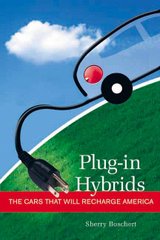"Let's bookmark this moment in the history of cars, because what is emerging is something like consensus. Hybrid doubters — who once railed that the batteries were sketchy, the costs of the so-called hybrid premium unrecoverable, the mileage gains overstated, and so on — are beginning to look like the Flat Earth Society. As underscored last month when GM announced it would build a plug-in hybrid version of its Saturn Vue, the logic of electric propulsion is compelling. Electric motors are clean, lightweight, maintenance-free and powerful. The latest lithium-ion batteries are energy-dense, durable, compact and recyclable. Putting these components together opens a world of oil- and carbon-saving possibilities."The automakers have been engaged in a snail's pace race toward greater efficiency and lower emissions. The Europeans have placed their bet on the more efficient diesel engine, achieving mpg ratings in excess of the Prius without the complication and expense of hybridization. Essentially, the Europeans believe cars will be all petroleum all the time for the forseeable future.
Toyota had a different take. Integrating highly efficient electric drive componentry into a gasoline-dependent internal combustion (ICE) vehicle results in desired greater mpg, but also provides a pathway to a better place, should the market or the government demand it. For the time being, the gasoline-only hybrids on offer are ICE preservers not ICE breakers. But add more batteries and an electrical plug to the design, and they've got instant access to power that radically changes the efficiency and emissions equation. Of course Toyota has little incentive to let the electrical genie too far out of the bottle. They've got their own profit-maximizing timeline. Hence, CalCars, EDrive, Hymotion and Hybrids Plus aren't waiting for the OEMs. They are putting plugs on hybrids today.
As it stands now, Toyota can incrementally improve their gasoline-only hybrids, staying out front in the mpg wars. No real motivation to plug in. Desperation, however, is a great motivator. Ford and GM, it would seem, need to throw a Hail Mary pass to get back in the game. Dan Neil suggests the ball is already in the air.
"Run this through your wetware: What about a car that uses a powerful electric motor to drive the wheels, that you would charge overnight like a cordless phone, that would deliver per-mile costs at a fraction of gasoline? And if the car should need to exceed its all-electric range, a small, hyper-clean gas-powered generator would be aboard to charge the battery. Such a widget, known as a serial hybrid, could get over 100 miles per gallon. Fantasy? Let's talk after next month's Detroit auto show."As the price of gasoline returns to its pre-election season highs, the plug is looking mighty attractive and close at hand. Let's hope Detroit is taking another look. With a push from Bush such as Thomas Friedman recently fantasized, instead of another greenwashing concept car for the forever-future, Neil's serial plug-in could hit showrooms in eighteen months. Perhaps, at long last, truly what's good for GM might be good for America.


